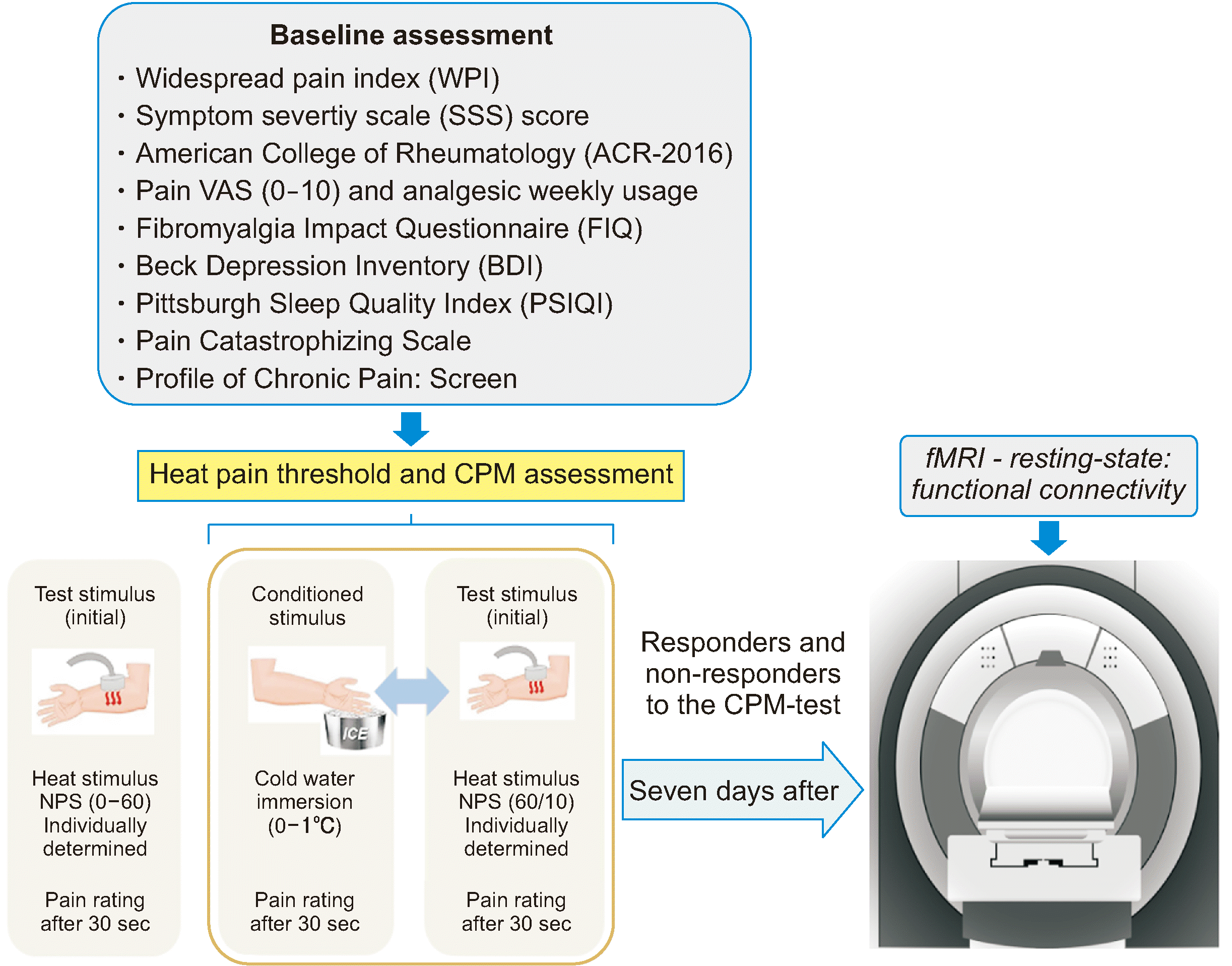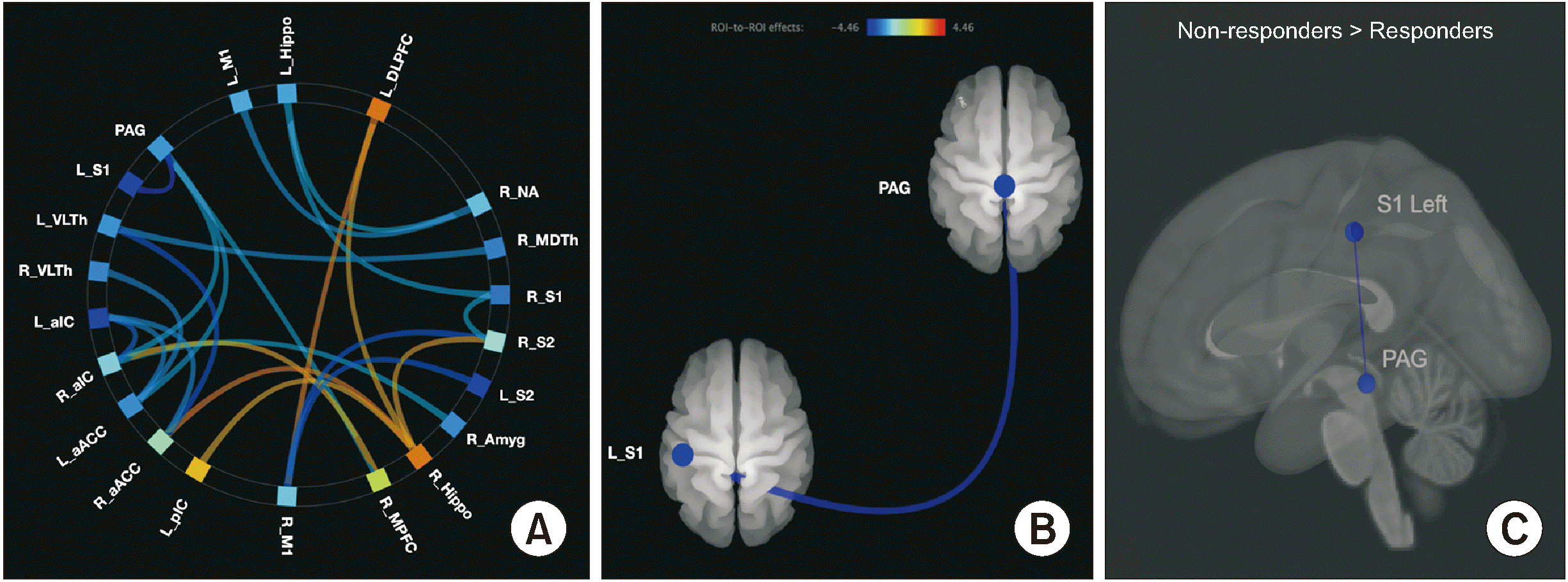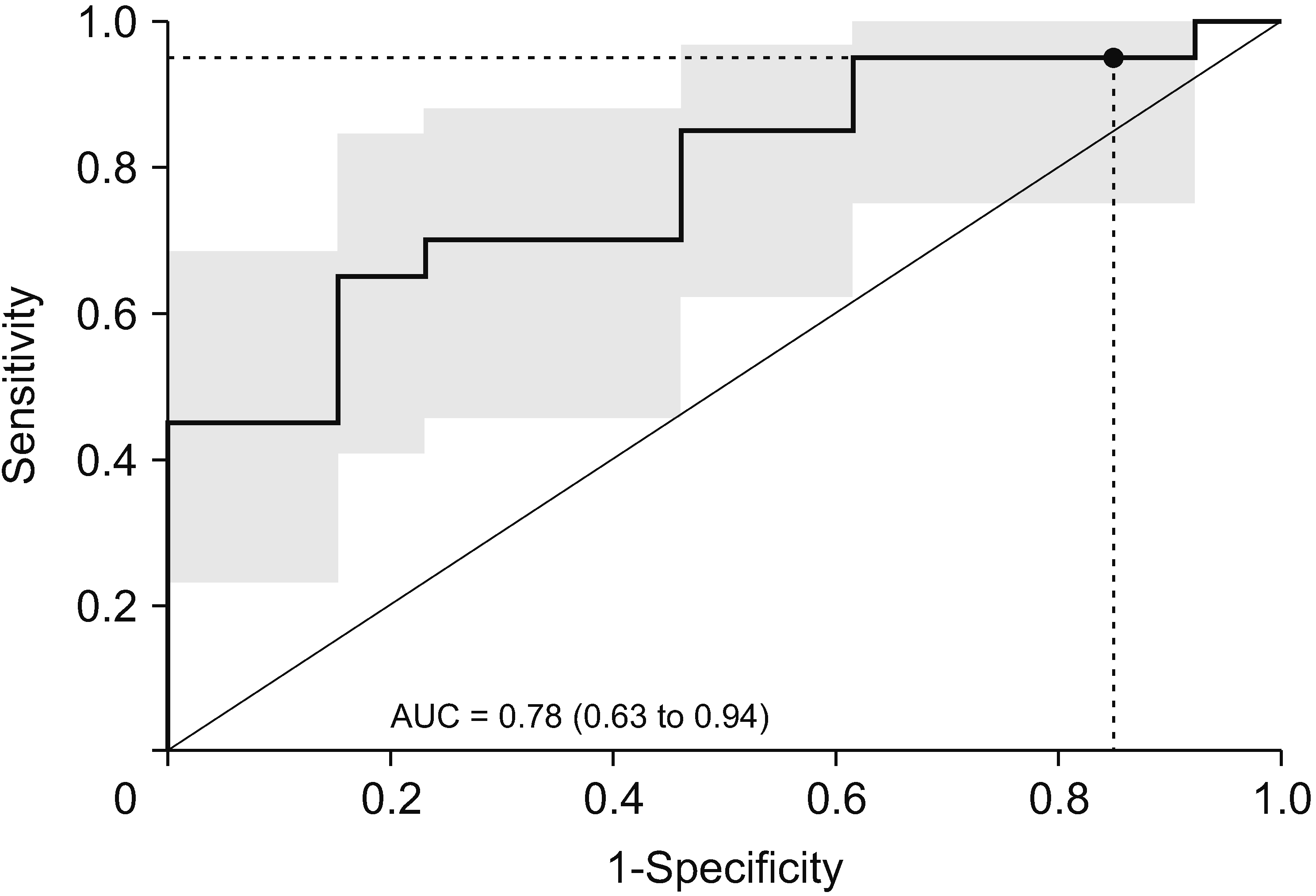1. Sawaddiruk P, Paiboonworachat S, Chattipakorn N, Chattipakorn SC. 2017; Alterations of brain activity in fibromyalgia patients. J Clin Neurosci. 38:13–22. DOI:
10.1016/j.jocn.2016.12.014. PMID:
28087191.
2. Cagnie B, Coppieters I, Denecker S, Six J, Danneels L, Meeus M. 2014; Central sensitization in fibromyalgia? A systematic review on structural and functional brain MRI. Semin Arthritis Rheum. 44:68–75. DOI:
10.1016/j.semarthrit.2014.01.001. PMID:
24508406.
3. Bidari A, Ghavidel Parsa B, Ghalehbaghi B. 2018; Challenges in fibromyalgia diagnosis: from meaning of symptoms to fibromyalgia labeling. Korean J Pain. 31:147–54. DOI:
10.3344/kjp.2018.31.3.147. PMID:
30013729. PMCID:
PMC6037812.
4. Apkarian AV, Bushnell MC, Treede RD, Zubieta JK. 2005; Human brain mechanisms of pain perception and regulation in health and disease. Eur J Pain. 9:463–84. DOI:
10.1016/j.ejpain.2004.11.001. PMID:
15979027.
5. Coulombe MA, Erpelding N, Kucyi A, Davis KD. 2016; Intrinsic functional connectivity of periaqueductal gray subregions in humans. Hum Brain Mapp. 37:1514–30. DOI:
10.1002/hbm.23117. PMID:
26821847. PMCID:
PMC6867375.
6. Coulombe MA, Lawrence KS, Moulin DE, Morley-Forster P, Shokouhi M, Nielson WR, et al. 2017; Lower functional connectivity of the periaqueductal gray is related to negative affect and clinical manifestations of fibromyalgia. Front Neuroanat. 11:47. DOI:
10.3389/fnana.2017.00047. PMID:
28642688. PMCID:
PMC5462926.
9. Yarnitsky D, Bouhassira D, Drewes AM, Fillingim RB, Granot M, Hansson P, et al. 2015; Recommendations on practice of conditioned pain modulation (CPM) testing. Eur J Pain. 19:805–6. DOI:
10.1002/ejp.605. PMID:
25330039.
11. Soldatelli MD, Siepmann T, Illigens BM, Souza Dos Santos V, Lucena da S, Torres I, Fregni F, et al. 2021; Mapping of predictors of the disengagement of the descending inhibitory pain modulation system in fibromyalgia: an exploratory study. Br J Pain. 15:221–33. DOI:
10.1177/2049463720920760. PMID:
34055343. PMCID:
PMC8138619.
12. Caumo W, Antunes LC, Elkfury JL, Herbstrith EG, Busanello Sipmann R, Souza A, et al. 2017; The Central Sensitization Inventory validated and adapted for a Brazilian population: psychometric properties and its relationship with brain-derived neurotrophic factor. J Pain Res. 10:2109–22. DOI:
10.2147/JPR.S131479. PMID:
28979158. PMCID:
PMC5589103.
13. Baliki MN, Mansour AR, Baria AT, Apkarian AV. 2014; Functional reorganization of the default mode network across chronic pain conditions. PLoS One. 9:e106133. DOI:
10.1371/journal.pone.0106133. PMID:
25180885. PMCID:
PMC4152156.
14. Wolfe F, Clauw DJ, Fitzcharles MA, Goldenberg DL, Häuser W, Katz RL, et al. 2016; 2016 Revisions to the 2010/2011 fibromyalgia diagnostic criteria. Semin Arthritis Rheum. 46:319–29. DOI:
10.1016/j.semarthrit.2016.08.012. PMID:
27916278.
16. Gomes-Oliveira MH, Gorenstein C, Lotufo Neto F, Andrade LH, Wang YP. 2012; Validation of the Brazilian Portuguese version of the Beck Depression Inventory-II in a community sample. Braz J Psychiatry. 34:389–94. DOI:
10.1016/j.rbp.2012.03.005. PMID:
23429809.
17. Sehn F, Chachamovich E, Vidor LP, Dall-Agnol L, de Souza IC, Torres IL, et al. 2012; Cross-cultural adaptation and validation of the Brazilian Portuguese version of the pain catastrophizing scale. Pain Med. 13:1425–35. DOI:
10.1111/j.1526-4637.2012.01492.x. PMID:
23036076.
18. Kaipper MB, Chachamovich E, Hidalgo MP, Torres IL, Caumo W. 2010; Evaluation of the structure of Brazilian State-Trait Anxiety Inventory using a Rasch psychometric approach. J Psychosom Res. 68:223–33. DOI:
10.1016/j.jpsychores.2009.09.013. PMID:
20159207.
19. Bertolazi AN, Fagondes SC, Hoff LS, Dartora EG, Miozzo IC, de Barba ME, et al. 2011; Validation of the Brazilian Portuguese version of the Pittsburgh Sleep Quality Index. Sleep Med. 12:70–5. DOI:
10.1016/j.sleep.2010.04.020. PMID:
21145786.
20. Whitfield-Gabrieli S, Nieto-Castanon A. 2012; Conn: a functional connectivity toolbox for correlated and anticorrelated brain networks. Brain Connect. 2:125–41. DOI:
10.1089/brain.2012.0073. PMID:
22642651.
21. Bastos AM, Schoffelen JM. 2016; A tutorial review of functional connectivity analysis methods and their interpretational pitfalls. Front Syst Neurosci. 9:175. DOI:
10.3389/fnsys.2015.00175. PMID:
26778976. PMCID:
PMC4705224.
23. Grabner G, Janke AL, Budge MM, Smith D, Pruessner J, Collins DL. 2006; Symmetric atlasing and model based segmentation: an application to the hippocampus in older adults. Med Image Comput Comput Assist Interv. 9(Pt 2):58–66. DOI:
10.1007/11866763_8. PMID:
17354756.
24. Makris N, Goldstein JM, Kennedy D, Hodge SM, Caviness VS, Faraone SV, et al. 2006; Decreased volume of left and total anterior insular lobule in schizophrenia. Schizophr Res. 83:155–71. DOI:
10.1016/j.schres.2005.11.020. PMID:
16448806.
25. Tseng MT, Kong Y, Eippert F, Tracey I. 2017; Determining the neural substrate for encoding a memory of human pain and the influence of anxiety. J Neurosci. 37:11806–17. DOI:
10.1523/JNEUROSCI.0750-17.2017. PMID:
29097595. PMCID:
PMC5719969.
26. Sours C, Alon G, Roys S, Gullapalli RP. 2014; Modulation of resting state functional connectivity of the motor network by transcranial pulsed current stimulation. Brain Connect. 4:157–65. DOI:
10.1089/brain.2013.0196. PMID:
24593667.
27. Tan Y, Wu X, Chen J, Kong L, Qian Z. 2019; Structural and functional connectivity between the amygdala and orbital frontal cortex in burning mouth syndrome: an fMRI study. Front Psychol. 10:1700. DOI:
10.3389/fpsyg.2019.01700. PMID:
31404248. PMCID:
PMC6669911.
28. Sevel LS, Craggs JG, Price DD, Staud R, Robinson ME. 2015; Placebo analgesia enhances descending pain-related effective connectivity: a dynamic causal modeling study of endogenous pain modulation. J Pain. 16:760–8. DOI:
10.1016/j.jpain.2015.05.001. PMID:
26022539. PMCID:
PMC4522336.
30. Hazlett EA, Buchsbaum MS, Zhang J, Newmark RE, Glanton CF, Zelmanova Y, et al. 2008; Frontal-striatal-thalamic mediodorsal nucleus dysfunction in schizophrenia-spectrum patients during sensorimotor gating. Neuroimage. 42:1164–77. DOI:
10.1016/j.neuroimage.2008.05.039. PMID:
18588988. PMCID:
PMC2548278.
31. Schreiber KL, Loggia ML, Kim J, Cahalan CM, Napadow V, Edwards RR. 2017; Painful after-sensations in fibromyalgia are linked to catastrophizing and differences in brain response in the medial temporal lobe. J Pain. 18:855–67. DOI:
10.1016/j.jpain.2017.02.437. PMID:
28300650. PMCID:
PMC6102715.
32. Schmidt-Wilcke T, Ichesco E, Hampson JP, Kairys A, Peltier S, Harte S, et al. 2014; Resting state connectivity correlates with drug and placebo response in fibromyalgia patients. Neuroimage Clin. 6:252–61. DOI:
10.1016/j.nicl.2014.09.007. PMID:
25379438. PMCID:
PMC4215460.
34. Marques AP, Santos AMB, Assumpção A, Matsutani LA, Lage LV, Pereira CAB. 2006; Validation of the Brazilian version of the Fibromyalgia Impact Questionnaire (FIQ). Rev Bras Reumatol. 46:24–31. Portuguese. DOI:
10.1590/S0482-50042006000100006.
35. Schestatsky P, Stefani LC, Sanches PR, Silva Júnior DP, Torres IL, Dall-Agnol L, et al. 2011; Validation of a Brazilian quantitative sensory testing (QST) device for the diagnosis of small fiber neuropathies. Arq Neuropsiquiatr. 69:943–8. DOI:
10.1590/S0004-282X2011000700019. PMID:
22297885.
36. Botelho LM, Morales-Quezada L, Rozisky JR, Brietzke AP, Torres IL, Deitos A, et al. 2016; A framework for understanding the relationship between descending pain modulation, motor corticospinal, and neuroplasticity regulation systems in chronic myofascial pain. Front Hum Neurosci. 10:308. DOI:
10.3389/fnhum.2016.00308. PMID:
27445748. PMCID:
PMC4921500.
37. Amorim P. 2000; Mini International Neuropsychiatric Interview (MINI): validation of a short structured diagnostic psychiatric interview. Braz J Psychiatry. 22:106–15. Portuguese. DOI:
10.1590/S1516-44462000000300003.
38. Hemington KS, Coulombe MA. 2015; The periaqueductal gray and descending pain modulation: why should we study them and what role do they play in chronic pain? J Neurophysiol. 114:2080–3. DOI:
10.1152/jn.00998.2014. PMID:
25673745.
39. Napadow V, LaCount L, Park K, As-Sanie S, Clauw DJ, Harris RE. 2010; Intrinsic brain connectivity in fibromyalgia is associated with chronic pain intensity. Arthritis Rheum. 62:2545–55. DOI:
10.1002/art.27497. PMID:
20506181. PMCID:
PMC2921024.
41. Gracely RH, Petzke F, Wolf JM, Clauw DJ. 2002; Functional magnetic resonance imaging evidence of augmented pain processing in fibromyalgia. Arthritis Rheum. 46:1333–43. DOI:
10.1002/art.10225. PMID:
12115241.
42. Cardinal TM, Antunes LC, Brietzke AP, Parizotti CS, Carvalho F, De Souza A, et al. 2019; Differential neuroplastic changes in fibromyalgia and depression indexed by up-regulation of motor cortex inhibition and disinhibition of the descending pain system: an exploratory study. Front Hum Neurosci. 13:138. DOI:
10.3389/fnhum.2019.00138. PMID:
31105542. PMCID:
PMC6494946.
43. Davis KD, Moayedi M. 2013; Central mechanisms of pain revealed through functional and structural MRI. J Neuroimmune Pharmacol. 8:518–34. DOI:
10.1007/s11481-012-9386-8. PMID:
22825710.
46. Agcaoglu O, Miller R, Mayer AR, Hugdahl K, Calhoun VD. 2015; Lateralization of resting state networks and relationship to age and gender. Neuroimage. 104:310–25. Erratum in: Neuroimage 2018; 167: 504. DOI:
10.1016/j.neuroimage.2017.10.025. PMID:
29054365.
47. Galambos A, Szabó E, Nagy Z, Édes AE, Kocsel N, Juhász G, et al. 2019; A systematic review of structural and functional MRI studies on pain catastrophizing. J Pain Res. 12:1155–78. DOI:
10.2147/JPR.S192246. PMID:
31114299. PMCID:
PMC6489670.
48. Lazaridou A, Kim J, Cahalan CM, Loggia ML, Franceschelli O, Berna C, et al. 2017; Effects of cognitive-behavioral therapy (CBT) on brain connectivity supporting catastrophizing in fibromyalgia. Clin J Pain. 33:215–21. DOI:
10.1097/AJP.0000000000000422. PMID:
27518491. PMCID:
PMC5296218.
49. Cook DB, Lange G, Ciccone DS, Liu WC, Steffener J, Natelson BH. 2004; Functional imaging of pain in patients with primary fibromyalgia. J Rheumatol. 31:364–78. PMID:
14760810.
50. Gasparin A, Zortea M, Dos Santos VS, Carvalho F, Torres ILS, de Souza A, et al. 2020; Brain-derived neurotrophic factor modulates the effect of sex on the descending pain modulatory system in healthy volunteers. Pain Med. 21:2271–9. DOI:
10.1093/pm/pnaa027. PMID:
32167540.







 PDF
PDF Citation
Citation Print
Print



 XML Download
XML Download